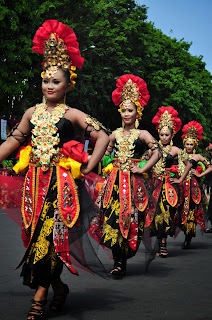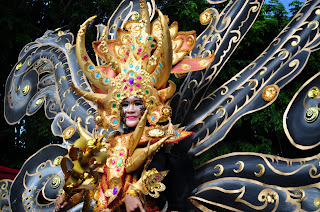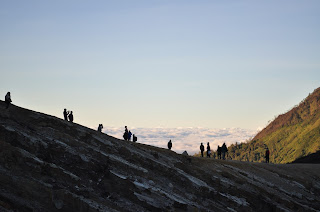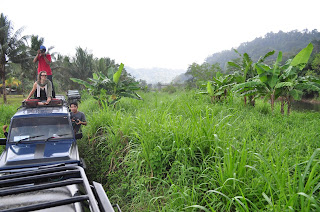Thankfully, my Idul Fitri adventure didn’t end after a short
week in Bali. From Munggu in Bali, I caught a bus to the island’s western tip,
and then took the ferry back to Banyuwangi in Java. Ucan, our coordinator, met
me at the harbor’s exit to bring me to the group’s hotel for the start of our
marathon tour in this corner of East Java.
I arrived in the early evening, right before dinner, to find
most people sleeping. While it’s not incredibly outlandish, since we nap all
the time, it was still odd. Ucan then told me to join the resting party,
because at 11 that night, we would set out to Ijen Crater to see its famous
blue fire. One of our participants found a great article about it, for some
in-depth information:
Kawah Ijen by Night
Before heading out, Banyuwangi’s tourism board gave us a
very warm greeting in the hotel restaurant, providing our dinner as well as
some beautiful batik souvenirs. Then, at 11ish (times aren’t very punctual on
tropical islands) we climbed into a trio of minibuses that carried us most of
the 2600 meters above sea level up the volcano.
Keep in mind, it’s so hot in Surabaya that I’ve never had to
wear long sleeves here, and only wore my sweatshirt in Gili to avoid a sandblasting
when I slept on the beach. This is to say that my idea of cold is now severely
warped. The high altitude of the mountain in the middle of the night meant
it would only be about 10 degrees Celsius, which feels terrible after 25 degree nights here. Granted, my available wardrobe in
Indonesia isn’t quite sufficient for that temperature.
Everybody dozed in the vans despite the violent rocking
inherent in navigating pot-holed, dirt, mountain roads. Then the driver opened
the door and we screamed in shock at the sudden, frigid-ish blast of the
almost-icy air. Reluctantly, when we accepted our temperate fate, as well as
the fact that the driver wasn’t going to close the door, we abandoned the
vehicles and stumbled towards our tour guide, and our only visible light
source.
He handed out face masks, to protect us from the sulfuric
gases pluming out of the volcano and then began our clumsy, short-breathed
three kilometer trek uphill to the top of the crater. It was a new moon that
night, and the trail is not lit, so we fumbled around in almost complete pitch
black for three hours, with the assistance of only a few flashlights that had
to shine for about 30 people. Most of our walk was in the black.
The going was tough. We were at a high enough altitude that
breathing was more difficult, and the hills were very steep at points, doubling
the effort. Consequently, I found myself supporting two of the dance
instructors, Fia and Erma, on both of my shoulders almost the whole way up.
While it was difficult, even treacherous, all of it was
rewarding. The cold wasn’t an issue once we started moving, and the crisp air
rejuvenated the lungs that receive so much abuse in Surabaya. Ijen, looming
invisibly above us, was so silent that we could hear the crashing waves of the
Bali Sea far below, and the absent moonlight allowed for completely
unobstructed stargazing. Shooting stars flashed across the entire atmosphere
with the glowing white of the Milky Way hanging prominently yet softly over the
middle of my view. I was more than happy to let Fia and Erma pause and catch
their breath so I could look at, but more importantly feel, the immensity and
the peace of the world around me.
 |
| The Surabayans struggled with the cold, too |
 |
| I couldn't see where the camera pointed, so Elmi's head got in there |
 |
| Hikers trailing behind us |
When we eventually reached the top of the crater, it was
windy, dusty, and now smelly. Our guide explained that the path down towards
the blue fire was treacherous, steep and, of course, dark, so those who didn’t
want to deal with even more exertion could hang out there until sunrise.
Despite utter exhaustion, probably exacerbated by the altitude, I chose
the potential danger over the certain cold of sitting at the top. My main logic
behind this was to move closer to the fire, which would theoretically provide some
warmth.
Some hesitant minutes later, about half the group decided to
descend the 200 meters on a narrow, poorly (if at all) maintained pathway towards the
flames. At the bottom, we regrouped, making sure everybody had survived.
Despite the opportunity to get closer to the flames, fatigue won and I nestled
into some rocks with Fia and Elmi, one of Surabaya’s cultural ambassadors and helper to Ucan, content with the view from our meeting point.
 |
| Face! |
Inside the crater was much warmer than above, but still fairly
uncomfortable, so the three of us huddled together, watching the dancing fires
and ducking our heads when the wind blew the sulfur gas in our direction.
Eventually I dozed off, waking up to the rapid “ayoh-ayoh! (let’s go, let’s go!)” of our guide. The sky was rapidly
getting lighter as the sun began its ascent for a new day.
Haylee, who actually went closer, got this great video of the flames:
Daylight makes hiking a thousand times easier. It took an
hour to descend into the crater, and only twenty minutes to climb out, if you
don’t count the extra half hour I spent creating the beginning of a movie with
Ucan. Now the top of the crater was the best place to be, as we could look out
over the clouds and the world for miles in every direction.
We returned to the hotel around 9:00, and had to be ready
for a city tour by 11. Some napped, and I energized with some extra helpings of
tea at breakfast. The tourism board then picked us up and brought us to the
mayor’s residence for a general history of Banyuwangi. Next we went to a
beautiful Chinese temple that mixed Confucianism and Buddhism, showing the
influence of the smaller religions in the area.
Our last stop for the day was a village just outside the city
where they were celebrating a traditional ritual to earn a prosperous harvest.
The elders choose a pre-pubescent girl as a kind of sacrifice to dance with the
gods in order to please them. She is in a trance the whole time, and the
ceremony takes seven days. I had never seen anything like this, and admittedly
felt a little weird watching. It turns out religious trances are a very intense
experience, even as an observer. Regardless, it was still fascinating to see
such a traditional event taking place, especially as the priests checked their
Blackberries during breaks.
Dinner that night ended up being a fantastic experience. The
local government had put a lot of effort into our visit, this night greeting us
at a restaurant with traditional dances and music in the street. This included a
barong performance (traditionally
meant to ward off evil spirits, it’s a two person character, with a lion mask. It
might make you think of a Chinese dragon) as we stepped out of the bus, and two musical greetings that ancient villages would use to keep up field
workers’ energy during rice harvesting led us into the restaurant.
I took videos, but a very uncooperative internet won't let me upload them. The first would have been two men in a watch tower playing bamboo instruments at a very rapid tempo, meant to hurry rice harvesters along in the fields. Second would be a group of elderly women making beats with large wooden poles against tree trunks. Traditionally, they would be pounding rice inside the trunks, and the beat would keep them going methodically and quickly.
After they let some of us try the rice-pounding beats, the
local newspaper got their photographs (
here we are, and that's me playing the rice trees) and we met the mayor, the
restaurant owner ushered us to a performance space where two stunning dancers
performed the
gandrung, the area’s
most famous dance. It was originally a ritual for the rice and fertility
goddess Dewi Sri, but now represents love and courtship, as well as a greeting
to visitors.
Because of its proximity to Bali, Banyuwangi and its
neighbor share a lot of characteristics, especially in the dances and music. I felt the same exciting and
energizing spirit from the rapid percussion of the gamelan and the hypnotizing movements of the dancers that I saw in
the Balinese dancing. What is interesting about it is that it is also decidedly
Javanese, despite its many shared characteristics with the other island. I could
really see the mixing of cultures here in the gateway between the two vastly
different places.
We enjoyed a delicious buffet, and then had time to learn some gandrung or chat with the
owner, who treated us to his very high quality java (I’m sorry, I had to). I
spent my time floating between the dancers and the coffee bar, plucking tasty
cookies from jars placed throughout the space and dipping them into my drink. I
usually don’t like black coffee, but this was good enough (for a non-snob, at
least) that even I enjoyed it. Everything was so wonderful there, from the people
to the performance and food, that we were all a bit sad to leave.
Keeping consistent with our trend of minimal sleep, we got
up at 5:00 the next morning for a series of jeeps waiting to take us into the
bush. Banyuwangi is famous for its biodiversity and surfing, making it a major
ecotourism destination so we spent the next two days out in the bush to
appreciate Java’s beauty.
 |
| Way into the bush |
 |
| Bad quality due to a very shaky ride |
First we went to Alas Purwo National Park, home of surfer’s
paradise Plengkung Beach, better known as G-Land. More importantly about the
surrounding forest is its spiritual significance in Javanese mythology as the spot
where the earth first emerged from the ocean (the name means first/ancient
forest). Before entering, the guides very seriously warned us not to curse and
to maintain a positive attitude (difficult for some) to avoid the evil spirits lurking
in the trees because of the area’s connection to the underworld.
Our first stop was something I definitely hadn’t expected to
see: a bright green savanna in the middle of the jungle, which is now a highly
protected area to care for some of Java’s endangered species. Environmental maintenance
and animal rights are still not major considerations for most Indonesians, so
the park has a lot of catching up to help these species. A simple example:
there is litter
everywhere. It's still on the right track for doing great work, though.
 |
| These three courtesy of Haylee, who stole my camera |
 |
| In the middle of dense jungle |
Unfortunately there was not a lot of time in Alas Purwo
because we had to get to Sukamade Beach in Meru Betiri National Park, a very
long and bumpy drive from where we were. I fell asleep between parks, while we
were on smooth pavement and the sun was out, and woke up to the jeep violently
bucking around in almost complete darkness. What I could see out the window was
dense, dense jungle.
Like Alas Purwo, the bush out here had a very dark spiritual
aspect. Riding through at night, especially since I woke up in the thick of it,
really let me feel its intensity. The forest is forbidding and imposing; you can feel in your stomach that you’re intruding. At one point we had to
stop to allow a python to cross the “road”; the silence and darkness closed in
around us, preying on our most primal fears. Even the two villages we passed along
the way were hauntingly instead of peacefully silent. When we had endured the
heavy jolts of traversing rock pathways for four hours (never going faster than
10km/hour), I’ll admit that panic even began to set in. Staying positive got increasingly
difficult as the jungle cursed our presence.
Of course we made it to Sukamade, after six hours of jungle.
The beach here is another protected area because of the sea turtle population
that comes to lay eggs on its sands. Travelers visit to learn about the sea
turtle conservation efforts, as well as watch first hand while rangers work to
protect them and their eggs. First we waited in the darkness, away from the
likely nesting places, while the rangers looked out for mothers to create their
nests. Once a turtle had begun her process (about midnight), they summoned us
with flashlights and we watched her lay the eggs, then the ranger counted and
collected them, bringing them back to a hatchery in order to protect them from
poachers and predators. They raise the baby turtles for about two weeks before releasing them into the waves on the same beach.
The idea of sharing these efforts is great, but I think they’ve
allowed it to become too touristy. For example, I don’t think it’s right for
people to use flash photography in a turtle’s face while she’s laying a hundred
eggs, but the rangers didn’t stop a particularly obnoxious tourist from going
so far as leaning on the mother’s shell for a photo. Tidak bagus (not good). Despite this frustration, however, I do
feel the project is overall a great pursuit.
We had the option to stay on the beach all night to watch
more turtles, but it had started to drizzle and I had to get at least a little
bit of sleep, which I’d been lacking for a week at this point. Early the next morning
we released 500 baby sea turtles into the water and then had to work our way back through the jungle.
 |
| A foggy morning gave the beach a haunting look |
 |
| I didn't take any pictures of the turtles, but I did find these adorable cats playing with our shoes |
Unlike at nighttime, the
daylight made the area beautiful and exciting, and much safer. So much so that
four people got to ride on top of the jeeps during our exit ride.
I selfishly grabbed a spot as quickly as possible.
 |
| Seat belt |
The roof was very uncomfortable, since I was sitting on a
metal grid with the squares big enough to fit four fingers through. My bum was
very sore after four hours on top of the car, but I’d argue it was just as
comfortable as inside, where the violent rocking of the jeep’s frame slammed
its occupants against the walls twice a second. Also, I saw some people
negotiating this path on motorbikes. They’re brave souls.
Along the way we forded a river (awesome, as seen above) and stopped at a
few beaches along the way. First was Green Bay, which I suspect is prettier
than the one in Wisconsin, although I haven’t actually been to the latter. It also
rained on and off during the ride, so when we reached the second, unnamed beach,
it was almost abandoned, allowing for completely free reign over the sand and
dangerous waves.
 |
| The Green Bay |
Four other people were there, though, and as coincidence would have it, two happened to be the Serbian and Argentinean girls that I had been in a movie with a couple weeks prior. It’s a small world, but the odds really were stacked against
this happening, especially since we had only meant to stop to wait for the last
two jeeps, and they were waiting for a transport up to Sukamade. I do love the
randomness of life and all the connections, or reconnections, it provides.
After pulling us away from that impromptu stop, we then spent an hour at another beach named Red Island, even
though it’s not an island. Most people ran straight for the sea again, but I stayed
behind with Fia and Ucan to indulge in the myriad snack stands across the
grounds. With them I tried what has potentially become my favorite sweet after
my mom’s cookies: terang bulan
(tuh-rahng boo-lahn; shining moon). It’s a really thick, sweetened pancake
folded around whatever filling you choose. Putting chocolate inside this
delicacy was exactly what I wanted, and I had to resist buying three, especially
since they were only about 50 cents each.
We stayed until about sunset and then returned to Banyuwangi
to spend the night before our rafting
trip the next morning. Ucan and Ibu Diaz’s family (they’re related) lives in
the city, so we stayed there and departed, as you may have guessed, early the next morning, with the
sunrise.
Hours of driving later (a major theme for the week), we
arrived at the rafting company, divided into boats, trekked to the start and spent two hours descending light
rapids. It wasn’t particularly challenging, and I think the goal was more to
soak ourselves, which we did thoroughly. It was a great laugh the whole way,
and the scenery was astounding. The river wound through a deep canyon with
mysterious caves and lush greens hanging all the way down the sides of the
bluffs. It was really difficult to decide between the excitement of the rapids
and the awe of the yawning gap through which we were riding.
Alas, all adventures must end, and after rafting and eating,
we got back in the cars one last time and began the ride back to Surabaya. I finally got the kind of adventures I had been craving, as well as the opportunity to solidify my friendship with some of the Indonesians in our group. What I got most from this second part of the holiday is that three months is far too little time, and I need to come back to see everything that I can. Even living here indefinitely wouldn't fully provide me the necessary time to get it all, but I know that eventually something will draw me back to experience it all again another way.


































































































